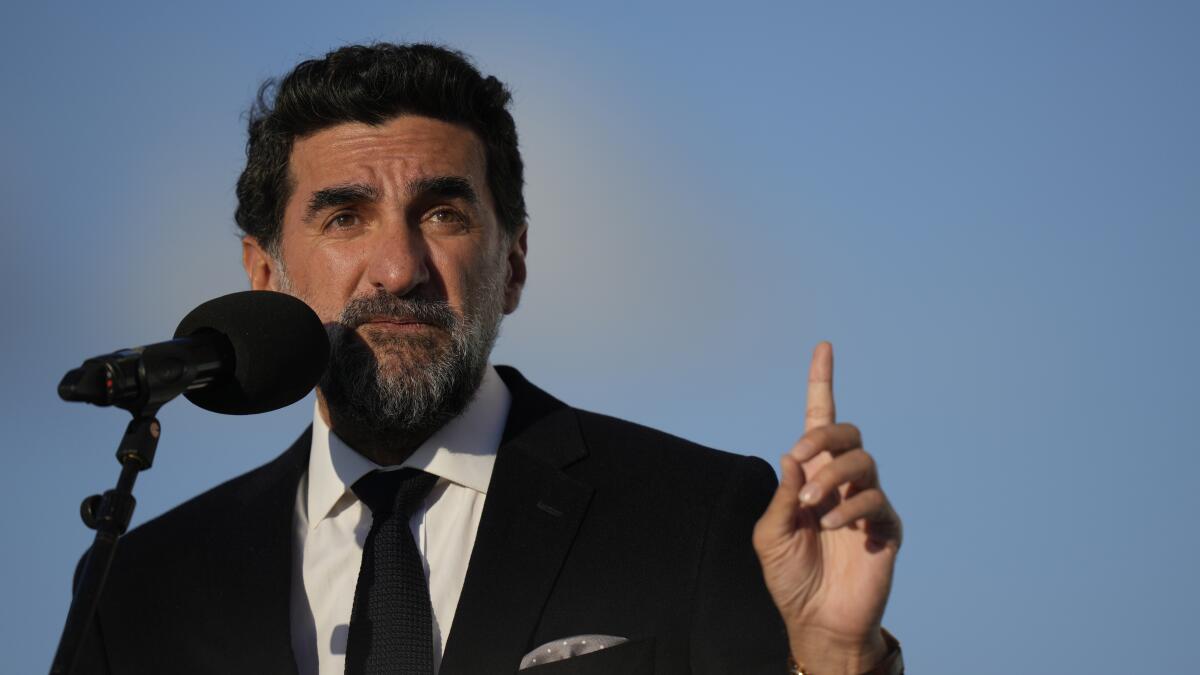Saudi-backed LIV Golf might be repugnant, but its bottomless billions terrify PGA Tour

- Share via
Consider the uphill climb facing the Saudi-backed LIV Golf series.
No TV deal. The audience is minuscule. The shotgun starts are a joke. The team concept is confusing and distracting. Aside from a few stars, the players are either has-beens or never-weres.
And yet the PGA Tour is terrified.
Because LIV Golf has billions to burn. Unlike other startup leagues that at some point have to face a financial decision about whether to carry on, this one appears to be a mile-deep well, and paid a reported $200 million to Phil Mickelson, $150 million to Dustin Johnson, and a $25-million purse to be split among the 48 players per tournament in the eight-event series — not to mention the winner of each collecting $4 million.
It’s all the talk of the U.S. Open this week, with Mickelson playing his first competitive golf on American soil in more than four months. Boston sports fans have never been shy, and Mickelson — once beloved by the galleries — surely will be heckled as he makes his way around the Country Club in Brookline, Mass.
Bad enough that he and the other defectors turned their back on the tour to take mountains of money from a Saudi government accused of numerous human rights violations over the years, but this week served as a reminder that 15 of the 19 hijackers in the 2001 terrorist attacks were from that country.
At his news conference Monday, the once-glib Mickelson was as tightly wound as an old Titleist, interrupting one reporter with, “Is there a question in there?” and chiding others not to try to sneak in a two-part question. He looked scruffy, weary, bedraggled and unassuaged by his bloated bank account.
That’s not a great head space in such a mentally taxing game, in which the space between the ears makes the difference between good players and great ones.
Phil Mickelson says he earned a lifetime PGA Tour membership and the tour shouldn’t be able to ban him because he’s playing in a new Saudi-backed league.
But, as these things do, the questions about Saudi money will eventually fade. It’s a hot topic now, yet something else will eventually take its place. LIV Golf, though, has the financial backing to keep churning along, and the tour has to be petrified that the just-add-water competitor has the resources to stay in the fight.
Maybe that’s why this is a much bigger deal than a Saudi prince owning War Emblem, which won the Kentucky Derby in 2002, or last year a Saudi-led consortium buying Premier League club Newcastle. Or that Formula One has a stop in Jeddah as part of a 10-year, $650-million deal with the kingdom.
LIV Golf isn’t the USFL. It isn’t the World Hockey Assn. It’s an existential threat to the PGA Tour, which for nearly a century has been the dream destination of millions of competitive players. And although the tour is far from perfect, it has enriched communities to the tune of $3 billion in charity over the decades.
If more players start to defect to the new league, especially some of the top-ranked ones, it could have a teeter-totter effect with still more players crossing over not just for the money but for the best competition.
Again, it’s hard to compete with somebody who has bottomless billions.

The tour is far from defenseless. As of now, LIV Golf events don’t factor into the official world golf rankings. So the lesser golfers in the new league, after a year or two of no ranking points, will have difficulty getting into one of the four major championships, even though the tour does not run those. (The Masters, for instance, accepts the top 50 players from the previous year’s rankings, plus the top 50 from the most recent rankings prior to the Masters.) A lot of LIV Golf players are going to be keeping close tabs on that rankings situation.
We also don’t know whether Augusta National is going to allow LIV Golf players to compete in the Masters, although it would be surprising if they were kept out. After all, that means banishing Mickelson, Johnson, Patrick Reed, Sergio Garcia, Charl Schwartzel and who knows which other past champions that might switch leagues. There would be plenty of empty seats at those green jacket dinners.
In order to hang onto its best players, the tour likely needs to make changes. It might start paying some type of appearance fees to its stars, perhaps locking in those amounts according to a player’s finish in the prior year’s FedExCup standings. Hey, Justin Thomas, Collin Morikawa, Jordan Spieth, Rory McIlroy ... whoever, if you win that season-long points competition, we’ll pay you a $1-million bonus for every tour event you enter next year. If you finish second, we’ll pay you $750,000 per appearance, and so on.
Rory McIlroy closed with an eight-under 62 to win the Canadian Open on a day when PGA Commissioner Jay Monahan criticized the Saudi-funded LIV Golf tour.
That would be a seismic shift from the way the tour has done business all these years, but we are entering an era of seismic shifts.
One of the cool things about golf is that money must be earned. Golfers don’t just show up and get paid. Imagine that in other sports, LeBron James and Matthew Stafford starting each season at $0 and getting paid by the win. Well, that’s the tradition in golf.
As traditions go, this new league is LIV and let die.
As for these 54-hole LIV Golf events streamed online, they are beyond strange, especially with the shotgun starts — everyone beginning at the same time on different holes. There’s no flow or rhythm like a typical tournament broadcast. The viewer doesn’t get a feel for the course. The first tournament was too much like the Red Zone Channel — jumping from shot to shot to shot — which works for football but not nearly as well for a cohesive golf narrative. And compared with a tour event, barely anyone tuned in.
The scary part for the tour is, that might not matter.
More to Read
Go beyond the scoreboard
Get the latest on L.A.'s teams in the daily Sports Report newsletter.
You may occasionally receive promotional content from the Los Angeles Times.













